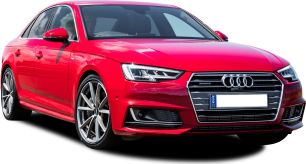Technical. Practical. Glorious. Three words I’d use to describe the cabin of the Audi A6 Allroad.
The cockpit isn’t anything out of the ordinary for an Audi of the modern era, and as such it will feel familiar to you if you’ve been in or around any of its more recent stablemates. It also means that you’ll find yourself in a high-end, high-tech and highly pleasant interior. The materials used are beautiful and of a high standard. They look very nice and it is an extremely pleasant place to be. And you can hate on me if you want, but I’m sold on brown leather. Yummo!
It will take some time for you to get to grips with the dual-touchscreen layout of the cabin, but once you get the hang of it, it becomes second nature.
The media screen is very easy to use, the menus are simple to learn, and over my week there were absolutely no issues with Apple CarPlay - either when connected via USB, or when used wirelessly.
The second screen below controls a lot of the main functions of the air conditioning system, and while I’m not a huge fan of using a screen to touch through temperature and fan controls, this one has haptic feedback and is well positioned - it’s not as much of a glance away from the road as in, say, a Land Rover or Range Rover. There’s also a volume knob which is good, and quick buttons for Drive Select and demister for front and rear windscreens.
In terms of the practicalities, there are bottle holders in the doors, a pair of cup holders between the front seats, a covered centre console bin with Qi wireless phone charging (remember not to leave your phone in there!) and there are two USB ports in there, plus a SIM card slot and SD card slot as well.
The seat comfort is very good - there’s electric adjustment on both seats with lumbar adjustment, and the driver’s seat gets memory settings as well. The electric steering wheel adjust is a nice touch as well, and there’s a remote boot release trigger, too.
There are twin sunroofs, and the front one can tilt and slide while the rear one is fixed. It helps lighten things up a bit if you have the optional dark headlining, which I personally wouldn’t choose.
Rear seat space is excellent. Sitting behind my own 182cm driver’s seat position, I had easily enough legroom, headroom and shoulder room - in fact, the rear pew is so accommodating, it could easily fit three of me across - but foot space is a little tight due to the large transmission tunnel.
Those in the back are well catered for – there are 2x USB ports, a pair of large door pockets with bottle holders, twin mesh map pockets, a flip down armrest with storage and cupholders, and our car had quad zone climate control (as part of the optional Premium Plus package - standard is three-zone climate), plus there are centrally mounted directional air vents and in the door pillars at face height. Our tester also had those optional manual sunblinds, which would certainly help those in the back get some shut-eye on longer trips.
The centre section of the rear seat can be split folded down on its own as well – so you have 40:20:40 rear seat folding, which is great for skis or snowboards. Plus there are two ISOFIX child seat attachments and three top-tether points available for baby seats. And one of the most excellent additions to any car ever – illuminated seat belt buckle receivers. It just makes it that much easier to see at night.
If you need to fold down those rear seats, there are boot-mounted triggers. That’ll help expand the luggage capacity from the standard 565 litres (VDA) to an expansive 1680L (VDA). The cargo hold easily fit the three CarsGuide suitcases (124L, 95L and 36L) with room to spare.
There is no Audi Allroad seven seater, though. And that’s potentially where something like a Q7 makes more sense, depending on your intent.

